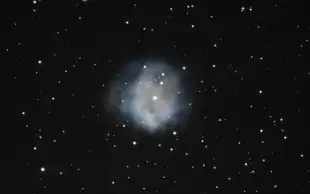NGC 6026
NGC 6026 ist ein 12,9 mag heller planetarischer Nebel im Sternbild Wolf und etwa 2400 Parsec von der Erde entfernt.
| Planetarischer Nebel NGC 6026 | |
|---|---|
 | |
| Aufnahme mittels Very Large Telescope | |
| AladinLite | |
| Sternbild | Wolf |
| Position Äquinoktium: J2000.0 | |
| Rektaszension | 16h 01m 20,9s [1] |
| Deklination | -34° 32′ 39″[1] |
| Erscheinungsbild | |
| Scheinbare Helligkeit (visuell) | 12,9 mag [2] |
| Scheinbare Helligkeit (B-Band) | 13,2 mag [2] |
| Winkelausdehnung | 0,67′ × 0,67′ [2] |
| Zentralstern | |
| Physikalische Daten | |
| Radialgeschwindigkeit | −87 km/s |
| Entfernung | 2398 pc |
| Geschichte | |
| Entdeckung | John Herschel |
| Datum der Entdeckung | 8. Juni 1837 |
| Katalogbezeichnungen | |
| NGC 6026 • ESO 389-PN7 • GC 4154 • h 3617 • | |
Er wurde am 8. Juni 1837 von John Herschel mit einem 18-Zoll-Spiegelteleskop entdeckt,[3] der dabei „F, S, R, 15 arcseconds, gpmbM. There are three stars forming a triangle about 60 degrees, N.p. the nebula“[4] notierte.
Weblinks
Einzelnachweise
- NASA/IPAC EXTRAGALACTIC DATABASE
- SEDS: NGC 6026
- Seligman
- Auke Slotegraaf: NGC 6026. Deep Sky Observer's Companion, abgerufen am 22. Mai 2016 (englisch).
This article is issued from Wikipedia. The text is licensed under Creative Commons - Attribution - Sharealike. The authors of the article are listed here. Additional terms may apply for the media files, click on images to show image meta data.